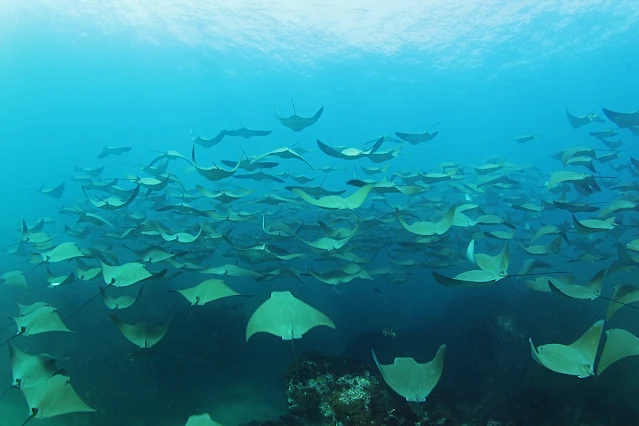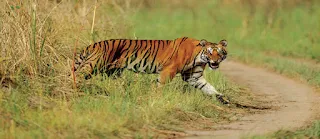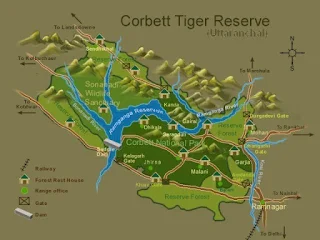The Cownose Ray is 11 to 18 inches (28 to 46 cm) in width at birth. A mature specimen can grow to 45 inches (1.1 m) in width, and weigh 50 pounds (23 kg) or more. There is some controversy over the size that a mature cownose ray can reach. A ray reaching a span of 84 inches has been recorded.
A cownose ray is typically brown-backed with a whitish or yellowish belly. Although its coloration is not particularly distinctive, its shape is easily recognizable. It has a broad head with wide-set eyes, and a pair of distinctive lobes on its subrostral fin. It also has a set of dental plates designed for crushing clams and oyster shells. When threatened the cownose ray can use the barb at the base of its tail to defend itself from the threat.
A cownose ray has a spine with a toxin, close to the ray's body. This spine has teeth lining its lateral edges, and is coated with a weak venom that causes symptoms similar to that of a bee sting.
A cownose ray is typically brown-backed with a whitish or yellowish belly. Although its coloration is not particularly distinctive, its shape is easily recognizable. It has a broad head with wide-set eyes, and a pair of distinctive lobes on its subrostral fin. It also has a set of dental plates designed for crushing clams and oyster shells. When threatened the cownose ray can use the barb at the base of its tail to defend itself from the threat.
A cownose ray has a spine with a toxin, close to the ray's body. This spine has teeth lining its lateral edges, and is coated with a weak venom that causes symptoms similar to that of a bee sting.
The cownose ray (Rhinoptera bonasus) is a species of eagle ray found throughout a large part of the western Atlantic and Caribbean, from New England, United States to southern Brazil (East Atlantic populations are now generally considered a separate species, R. marginata). Cownose rays grow rapidly, and male rays often reach about 35 inches (89 cm) in width and weigh 26 pounds (12 kg). Females typically reach 28 inches (71 cm) in width and weigh 36 pounds (16 kg).

Cownose rays breed from June through October. A large school of cownose rays gather of varying ages and sexes in shallow waters. A female will swim with the edges of her pectoral fins sticking out of the water, with male cownose rays following her trying to grasp the fins to mate. The embryo grows within its mother with its wings folded over its body. Initially it is nourished by an egg yolk, although the uterine secretions of the mother nourish it later in its development. The length of gestation is disputed, but it is believed to last between 11 and 12 months and is variable. At full term, the offspring are born live, exiting tail first.
The cownose ray feeds upon clams, oysters, hard clams and other invertebrates. It uses two modified fins on its front side to produce suction, which allows it to draw food into its mouth, where it crushes its food with its dental plates. Cownose rays typically swim in groups, which allows them to use their synchronized wing flaps to stir up sediment and expose buried clams and oysters.
The cownose ray often migrates from the Gulf of Mexico to Trinidad, Venezuela, and Brazil twice in a year. Cownose rays migrate in groups of up to 10,000 as they glide their way silently towards their summer feeding grounds.
Migration may be influenced by water temperature and sun orientation, which explains the seasonal migration pattern. Southern migration may be influenced by solar orientation and Northern migration may be influenced by the change in water temperature,
Cownose rays do migrate, but as of yet, it has not been determined that their migratory behavior is due to feeding or premigratory mating activity.


















































